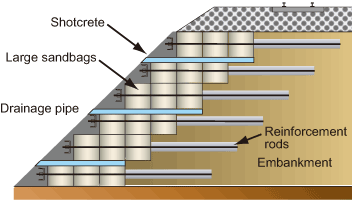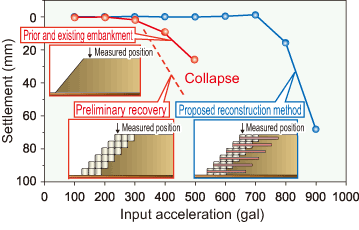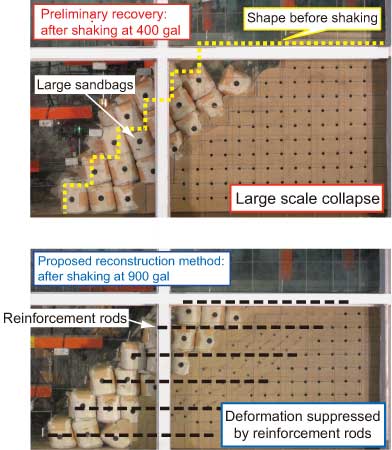4. An early reinforcement/reconstruction method for damaged embankments
- The RTRI developed a reconstruction method to reinforce damaged embankments as soon as possible using large sandbags and reinforcing rods.
- This reconstruction method means that, after preliminary repair work, longer term construction work can be performed for more permanent repairs while maintaining rail operations.
Repair of damaged embankments often involves two stages of reconstruction: preliminary repair using large sandbags followed by permanent repair. This approach is aimed at prompt re-establishment of rail operations, by utilising large sandbags for which soil gathered at the site can be used, and offers excellent workability characteristics. However, completion of the work is time-consuming and costly because permanent repair involves removing the previously placed large temporary sandbags.
Accordingly, RTRI developed a new reconstruction method which would reinforce and repair embankments from the outset. This approach is intended to improve the stability and reinforce the whole embankment by utilising the large sandbags already used in preliminary repairs skewered with rods for resistance (Fig. 1). The advantage of the proposed method is that it halves the work period compared with existing repair techniques and contributes to permanent reinforcement after preliminary work given that subsequent construction work is done as a continuation of preliminary work while maintaining rail operations. A shaking experiment using a 1/10 model of a real object demonstrated that the method can:
- - suppress deformation even during large earthquakes (Fig. 2),
- - offer higher aseismic capacity compared with prior and existing embankments and preliminary repairs, and
- - offer a sufficient level of performance as a regular repair technique (Fig. 3).
Drain holes are also arranged in the same way as with ordinary reinforced earth-retaining walls to cope with rainfall.
 Fig. 1 Outline of the proposed reconstruction method
Fig. 1 Outline of the proposed reconstruction method
 Fig. 3 Aseismic capacity with the proposed reconstruction method
Fig. 3 Aseismic capacity with the proposed reconstruction method Fig. 2 Model embankment shaking experiments
Fig. 2 Model embankment shaking experiments